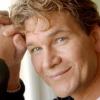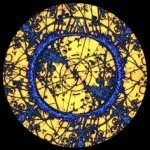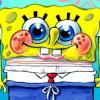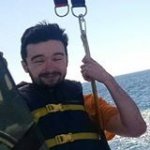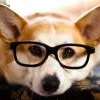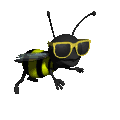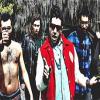Leaderboard
Popular Content
Showing content with the highest reputation since 11/14/2010 in all areas
-
Last weekend I crossed the border into Toronto, Canada for a "girls weekend" with my mom and sister. Our main purpose of going there was for a yoga convention for all the yogies of the world. While at this convention, we of course experienced tons of physics! When doing different yoga poses, we experienced the great phenomenon-gravity- at work. When "ohming" or saying "namaste" we experienced sound waves, and the vibration they produced so that we could here them. But when we weren't doing yoga, we somehow still experienced physics! By dropping tons of money at the 3-story mall, The Eaton Centre, we experienced the force that our heavy shopping bags created on our arms. When taking the elevator to a new floor of designer stores, we experienced physics there and how we felt heavier when going up, but lighter when going down due to acceleration. We lastly saw physics when we hit the pool/hot tub in our wonderful hotel. The jets pushed water out creating different waves or bubbles. We also created waves by jumping into the pool. Depending on the type of jump or how hard it was, the amplitude changed all the while carrying the energy we put forth by jumping in. This weekend adventure was full of physics just like everything else!3 points
-
So are you saying that in one of these dimensions you're actually good at super Mario??. Fascinating stuff Jake, and don't go putting your cats in radioactive boxes, alright big guy?3 points
-
The Space Race between both the USSR and the United States is by far one of my favorite eras of history to study. They say competition is the perfect motivation, and I truly believe, from a technological standpoint, this is era is a prime example of that motto in its purest form. Some of the biggest strides in human history were made in a time where computers were still the size of rooms all due to fear, curiosity, and drive. Public Service Broadcasting’s album, “The Race For Space”, tries to capture all of these emotions, during a handful of critical points, along this journey in order to show how important this period was for Humanity as a whole. (I will cover the tracks in event order not track order) Track 2: Sputnik The year is 1957, and, as tensions of the Cold War are ever increasing with no end in sight, humanity has its eyes on the one place neither power has even traveled: space. The Soviets, ever fearful of the United States launching into orbit, rushed through their plans to launch a 3,000 pound satellite equipped with various scientific instruments. They ended up downsizing dramatically to a 184 pound payload with a 58 centimeter diameter without any instruments. On October 4th of that year it was launched on a R-7 rocket with four stages. It nearly suffered a catastrophic launch failure, but the a combination of engine thrust and wing movement saved it last second. Well what did it do? It beeped. And that beep was the beep heard all around the world. Well at least for 22 days… its batteries actually exceeded the expectation of 14 days. For the first time in all of human history something was able to orbit the earth. It wasn’t the first man-made object in space, but it was the first which was in continual free fall around the earth. So, yes, the Soviets to prove themselves put a beeping piece of metal into orbit because that is all they needed to do to stir so much amazement and fear. The device whose name directly translates to “travelling companion”, would be the spark which set the both countries ablaze and straight into the most heated technological race in all of human history. Track 3: Gagarin It is now April 12th, 1961. Multiple years have passed since Sputnik, but no shortage of tests and animals had been launched into space, including the famous cosmonaut dog Laika on Sputnik 2. Now it was time to push the barrier forward onto man's reach into space. Enter Yuri Alexeyevich Gagarin. A 27 year old Senior Lieutenant Gagarin was chosen out of over 200 Russian Air Force fighter pilots by peers and project heads due to his exceptionally quick thinking and attention to detail. At 9:07 A.M. Vostok 1 took off carrying Gagarin on board. Due to the feared consequences of free fall, the Russian mission control was totally in control of the craft the entire time. Yuri was the first human ever in space, a true high water mark achieved by humanity. His trip lasted one obit, a total of 108 minutes. While the United States press showed fear of losing the space race, he was seen in many places as a hero for humanity, going on a global world tour to be paraded around countries including England, Canada, and, of course, across the USSR. This stance of him being a pioneer, regardless of national affiliation, is what PBSB was aiming for in their upbeat track. Looking back now it is easy to say he was a true pioneer for all of humanity and his efforts will forever go down in history as that of a hero. Track 1: “The Race for Space” The date is now September 12th 1962. President Kennedy is making a speech to 40,000 people in Rice Stadium. At this point, the United States is far behind in the space race launching the first American, John Glenn, nearly a year after Gagarin. Kennedy knew he needed to rouse the American spirit, and, in effect, his speech became a defining speech in American history. A link to the full speech can be found here: https://er.jsc.nasa.gov/seh/ricetalk.html. Perhaps one of the most ambitious technological proposals made by a president, Kennedy promised that by the end of the decade America would put a man on the moon. Keep in mind no spacewalks had been taken, lunar modules had been made, no docking sequences had even been practiced, and here was the nation’s leader saying we could make it in 8 years or less. The National Defense Education Act had been passed due to Sputnik and had been in effect since October 4th 1957. Now its efforts of acting as a booster for the mathematics and science related fields was beginning to see results. Young engineers and scientists began coming out of Universities in order to rapidly increase the nation’s technological investments to bound ahead. This key moment not only left the nation space crazed, but made getting to space a budgeted objective at the front of the nation's interest. This vow and critical commitment is what would pave the way for the American Space program to come, as now Americans all over had their eyes on the skies. Track 7: “Valentina” Fast forward to June 16th, 1963, Vostok 6 is launched. It is the last in the man orbital missions launched by the USSR starting with Gagarin. Well what made this so different? This time the passenger was Valentina Tereshkova. Yes, the first woman in space. Her mission lasted 3 days and she kept two way radio communications with Voltok 5 which was orbiting with her. In this time she made 48 orbits, which was quite a large feat at the time. Her personal background was that of an avid skydiver and textile factory worker making her the first civilian in space as well. The space suit she wore was the MK-2 which was very similar to the MK-1 that Gagarin wore. These suits were only meant to be pressurized in an emergency, such as if the cabin was punctured. It would take a better space suit in order to do an EVA which is the coming up milestone. Up until this point, humans have remained within their pressurized cabin in order to take a safe trip, but now we move onward and upward by finally getting out of the restrictive hull. Track 5: “E.V.A” On the 18th of March 1965, the Voskhod 2 mission was launched. Two cosmonauts were abroad: Pavel I. Belyayev and Alexey A. Leonov. Belyayev was the primary pilot while Leonov was the secondary, but he had a far more important mission. He was to perform the first E.V.A trialing the first space suit with a life support system in the backpack. The flight lasted 26 hours and made 16 orbits. During this time the first spacewalk lasted approximately 20 minutes with Leonov claiming the experience gave him a sense of complete euphoria and tension at the same time. The mission, being reported as a major success, acted as a dramatic blow to the United States government. At the same time, many catastrophic failures occurred while in space, but were never reported on the ground. A few moments after Leonov stepped out of the shuttle he realized his suit had inflated to the point he could not get back in. He needed to decompress, and as he let out oxygen he began feeling the initial symptoms of decompression sickness. He began pulling rapidly on the cord thrusting himself in with a moment to spare, but at his current temp he was at risk of heat stroke. His perspiration blocked his view so he had to maneuver around the airlock blind. He eventually did it and made it back in to the safety of the shuttle. This was only the start of the problems though. Due to this maneuver the oxygen content of the shuttle soared, meaning any single spark would have it blow up as quick as a flash. They managed to lower the oxygen concentration back to a safe levels. The ultimate test occured when they had to manually re-enter the atmosphere due to engine problems. They were exposed to high G forces along with high temperatures only to land off course in Siberia. They were eventually recovered and hailed as heroes. This was yet another large step to making it to the moon with the United States still lagging behind. And they were soon to have one of their largest hardships to date. Track 4: “Fire in the Cockpit” On the 27th of January 1967, an event which would live in national infamy occurred. The Apollo 1 space crew, comprised of Virgil Grissom, Edward White, and Roger Chaffee, all entered their command module to undergo a simulation for their up and coming launch. The first problem arose when Grissom complained of a “sour smell” in the spacesuit loop, but decided to continue the test. This was followed by high oxygen flows triggering on and off the alarm. This wasn't resolved as the communications were experiencing problems resulting in the line being only between pilot Grissom and mission control. At 6:31, oxygen levels quickly rose as Chaffee casually says he smells fire, but within two seconds, White proclaims, “Fire in the cockpit.” Escape procedure was supposed to take ninety seconds, but ultimately that time frame was too long. In the highly oxygenated environment, the fire spread too quickly, followed by the command module rupturing forcing black smoke across the landing pad. An eventual investigation found that the fire was started by a faulty bundle of wires located behind their heads. It took firemen three minutes to quell the fire and to open the doors, but it was too late all three perished. It was a day of national remembrance and an overall low in the American Space program up until that point. Their sacrifices were distinguished with the highest regard as the nation mourned and tremendous loss. Track 8: “Go!” Apollo 11 is by far the most known aspect of the space race. It is the moment where scholars say the United States sealed their place as the winners of the space race. It inspired kids for years to come to become astronauts. The Apollo 11 mission’s ultimate goal was to land the first man on the moon fulfilling Kennedy's earlier promise and legacy. Apollo 11 launched on July 16th, 1969 with astronauts Neil Armstrong, Michael Collins, and Edwin “Buzz” Aldrin. It took 75 hours to reach lunar orbit. This is where the focus of the song is. It includes a systems check as the lander makes it's landing maneuver and lands on the surface. The utter tension at mission control was palpable. This was the most critical part of the mission, and when they landed, from the utter joy heard over the radio, the public knew they had finally done it. Tee descent began at 102:33 with the ultimate touchdown resulting at 102:45. After a period of set up and a postponed rest period, Armstrong made his exit onto the surface at 109:24:19 to utter those famous words. Aldrin soon followed behind with the whole thing being broadcasted to the American Public. This moment, the moment where America gathered around their television screens to watch them be the farthest away from anyone else that any human has ever been, was the height of the space race. They made their return launch starting at 124:22 and plunged back into the Pacific Ocean on July 24th. These pioneers set the standard of human exploration in the space age and acted as role models for new explorers for years to come. Track 9: “Tomorrow” The last track of the album is of course the most inspirational. It focuses around Apollo 17, which was the last manned mission to the moon. it was launched on December 7th, 1972 with crew members Eugene Cernan, Ronald Evans, and Harrison Schmitt. It's main objectives were to put a Rover on the moon, conduct testing, and take samples such as moon rocks and photographs. In total over 16 hours of EVA were conducted, 30.5 kilometers we're traversed by the rover, and 243 pounds of samples were collected. The mission was a success but extremely bitter sweet being the last mission in the Apollo chapter. It ultimately completed the era of the Space Race. It has much more sentimental value in this aspect, as the track takes the time to reflect on the previous decade and a half of progress and how far the human race has come. Ultimately the space race was a period of history where nations gathered behind the scientific progress they conducted. Yes, there was always the fear of mutual destruction, but the sense of shared awe at what humanity achieved far overshadows that factor when looking back at history. There are not many periods of history where technology progressed at such breakneck speeds, and may not be for a long time. There is plenty more to read about the period, and I encourage you to do so if this interested you at all. As always it had been a pleasure! This is ThePeculiarParticle, signing out. Informal Bibliography Esa. “The Flight of Vostok 1.” European Space Agency, European Space Agency, www.esa.int/About_Us/Welcome_to_ESA/ESA_history/50_years_of_humans_in_space/The_flight_of_Vostok_1. “The First Spacewalk.” BBC, BBC, 2014, www.bbc.co.uk/news/special/2014/newsspec_9035/index.html. Larimer, Sarah. “'We Have a Fire in the Cockpit!' The Apollo 1 Disaster 50 Years Later.” The Washington Post, WP Company, 26 Jan. 2017, www.washingtonpost.com/news/speaking-of-science/wp/2017/01/26/50-years-ago-three-astronauts-died-in-the-apollo-1-fire/?noredirect=on&utm_term=.7d4feb08cec3. “NASA.” NASA, NASA, www.nasa.gov/. “National Air and Space Museum.” The Wright Brothers | The Wright Company, airandspace.si.edu/. RFE/RL. “Kennedy's Famous 'Moon' Speech Still Stirs.” RadioFreeEurope/RadioLiberty, RadioFreeEurope/RadioLiberty, 13 Sept. 2012, www.rferl.org/a/kennedy-moon-speech-rice-university-50th-anniversary/24706222.html. “Space.com.” Space.com, Space.com, www.space.com/. “Sputnik Spurs Passage of the National Defense Education Act.” U.S. Senate: Select Committee on Presidential Campaign Activities, 9 Mar. 2018, www.senate.gov/artandhistory/history/minute/Sputnik_Spurs_Passage_of_National_Defense_Education_Act.htm. (Disclaimer the websites were used many times for different articles)2 points
-
2 points
-
The reason why you get shocked more in the winter is because everyone has their heaters on which draws the moisture out of the air which causes the charges to build up and cling to us more since there is less moisture in the air.2 points
-
...(But probably not.) In light of the holiday season, I bring to you a Christmas-themed blog post, with a pinch of love and some hints of gravitation. I came home from school today and stepped into the living room, astutely noticing that the Christmas tree had fallen. Obviously, the first thing that ran through my mind was that gravity did this. I mean, gravity's everywhere - it's a pretty likely culprit. You may or may not notice the lamp just above where the tree fell, but I believe it to be of great importance in this investigation. I have deduced that, at any time from 10:00 AM to 2:00 PM on Tuesday, December 16, the gravitational attraction between the tree and lamp created a gravitational orbit that forced the tree out of its holder, and onto the cold ground. Let's take a look. First off, the tree had to begin in static equilibrium - it was still at first. Due to Newton's first law, an outside force had to act upon this tree, and I do believe that the placement of the lamp near this tree provided an IMMENSE GRAVITATIONAL FORCE. So let's dive in. We know that the magnitude of this force is given by GMm/r^2, where G is a constant, M is the tree, m is the lamp, and r is the distance between the two. G = 6.67E-11 Nm^2/kg^2, we know this. The average mass in kilograms for a Christmas tree is about 70 pounds at this height of tree, or 31.75 kg. The mass of the lamp is about 8 pounds, or 3.63 kg. I can already see this force is about to be massive. And the distance between the center of mass of the tree and lamp? About 5.5 feet, or 1.68 meters. Time to calculate. F = [(6.67E-11 Nm^2/kg^2)(31.75 kg)(3.63kg)]/((1.68m)^2) Therefore, the force due to gravity is a whopping 2.72 NANONEWTONS. This incredibly large force undoubtedly caused the displacement of the tree; therefore, gravity ruined Christmas. You may be subconsciously pointing out the holes in my story, like how did a gravitational orbit just occur if the lamp was there the whole time, or perhaps just pointing out the fact that two objects on Earth will likely only apply negligible forces to each other. Fair enough, but keep in mind that there is absolutely no other worldly explanation for this phenomenon. So it's either gravity, or ghosts. You decide. Or maybe the cat just knocked it over.2 points
-
Physics is involved in pretty much everything in life. Throughout my school day I experience all kinds of physics. First period I have Italian where I sit down (along with the rest of my classes) and I am applying a force to the chair and the chair is applying a force to me because of Newtons third law. Second period when I get my math test score back I hit my head against the desk which is also applying a force to the desk and the desk applies one right back. Third period is art class where I gravity is pushing my eyelids down while I struggle to stay awake. Fourth period is APUSH which could be compared to a black hole. Black holes have tons to do with physics. A black hole is a point in space with so much gravity that not even light can escape and that is most definitely APUSH... Fifth and 6th periods are the best of the day because I do not have classes these periods so I can do my homework. Seventh period is English where I push down on my pencil and it leaves a mark on the many papers I have to write. Gravity also pushes down on that pencil. Eighth period could be the first period of a double for physics or if I am lucky its gym. In gym there is so much physics. A ball is thrown and is a projectile motion. Gravity acts on the ball at all times. If were running in gym we push down on the ground with our legs and the ground pushes us back allowing us to run. And then ninth period, well there is too much physics in a physics class to list. Tons of gravity throughout the day and tons of newtons laws. Crazy..2 points
-
So if you haven't heard, a rocket that was supposed to bring supplies to the International Space Station (ISS) exploded on October 28. Here's a short article and video talking about it: http://www.wired.com/2014/10/antares-rocket-explosion/. Obviously, this kind of sucks. The rocket cost about $200 million and now most of the supplies won't make it to the ISS. However, explosions are still really fun to watch, especially one that big and I don't feel bad saying that since the rocket was unmanned. Also interesting is that the rocket was made by Orbital Science, under contract of NASA. This shows that the space industry is slowly because more of a private industry with Orbital Science and SpaceX leading the way at the moment. They aren't sure exactly what caused the rocket to fail, but the actual explosion was caused by the self-destruct being purposefully activated. The real problem was right when it fired its first stage - you can kind of see this in the video. As soon as this problem was noticed, it was decided to destroy the rocket before it reached a populated area and could potentially cause damage. Any number of factors can mess up a rocket launch; there are a lot of variables. Wind speed and direction, an area clear of people, weather, calculations, etc. I think the biggest things I learned from this are that those errors we usually don't account for in our physics labs (FRICTION!!) matter a lot in the real world, and that we still have not perfected going to space. I'm excited for space tourism anyway.2 points
-
Hello, my name is Max and I'm a senior in high school. Since everyone else is talking about the sports they play...I will too. My mother often asks me to stop playing tennis because it is such a physical sport, but I rarely listen to her so I continue to play at a varsity level. I can't have any pets except a boring fish because my dad is allergic to the fur on cats and dogs. At the moment I work at a restaurant called Hose 22 and I usually prepare food. I'm taking physics because it was recommended to me by my counselor. But I am excited to start physics because it looks like its going to be very different from all the other science classes. I also really want to learn more about the different forces that can act on objects.2 points
-
Jelliott, I can really relate to your analogies. I too wish to become a beautiful butterfly, to grow and grow until I burst with knowledge. although I find some of your post humorous as intended, I think you struck on very important ideas. I think hard problems can be torture but on the other hand, that makes them that much more rewarding when completed.2 points
-
If you wanted to, you can change your name and remove your last name in the settings! Enjoy physics!!2 points
-
2 points
-
Sweet blog post. If you wouldn't mind spreading the love and also buying your two student teachers silver Porsches, we wouldn't complain2 points
-
Soooo, because this is my last blog post for this year ( ), I thought it would be fitting to do a course reflection on the AP-C physics class this year. I thought I'd do it in a "bests-vs-worsts" top 5 format, kind of like you could find on collegeprowler.com when viewing different schools. Top 5 Bests: 5.) Blog Posting [i thought this was really fun! I've never done anything like this before for a class. It brought up interesting physics applications and I thought it was fun to converse with classmates on the site ] 4.) Independent Units [As uncomfortable as I was at first, independent units forced me to manage my time, work harder than usual to learn the topic, and was great preparation for college. I feel like everyone sould experience this kind of a unit before graduating] 3.) Assigned practice problems from the readings [Assigned problems were REALLY helpful. I would've struggled a lot more than I did had I skipped doing the sample problems] 2.) Units with Lecture & book follow-up [This is my favorite way to learn things! The read-then-lecture method] 1.) VIDEOS <3 [Hands down the most helpful resource in Physics] Top 5 Worsts: ...I think this is my biggest beef. I really don't have 5 things to complain about. 1.) Readings weren't assigned [When life gets busy in the middle of the year, especially with a number of APs, sports, etc., readings are the first thing to get cut out for me if they're not assigned. Confession: when the going got tough, I would often skim or not read. I reccomend assigning readings in the future. Kids will complain, but they'll thank you when they see better grades and their AP score.] Overall, this was a successful year. A note to future students: This is by far the hardest AP course I've taken throughout high school. If you want to succeed, you must: A.) Read the textbook and do some practice problems B.) WATCH THE VIDEOS. Whether you're confused or simply want review, these are soooo outrageously helpful. It's like being in class a second time, except in 15 minutes or less instead of 42. Plus, you can skip over any sections that you feel you know solid. C.) REVIEW THE EQUATIONS AND FREE RESPONSE BEFORE THE AP. I went through most of the E&M free response questions as well as both E&M and mechanics equations before the exam. KNOW THE EQUATIONS! I swear equations and key concepts are the majority of the test when it comes to the multiple choice Qs. Any favorite parts of the year? Things you wanted to change? Post below with your opinion! ...I can't believe we only have 1 more day of physics2 points
-
PCX is a workout area that I participate at weekly with my volleyball team. We go on tuesday nights to exercise as a team. I realized while watching videos that i recorded of the exercise's how much physics was applied into each activity. The vertamax that we use for jump training is full of physics. When you use the vertamax you put on a belt with two clips on either side of your hips. You then stand ontop of the vertamax (a square flat surface) and then attach the clips to different color resistance bands. With the vertamax at PCX you can either choose to use it for jump training or leg strength by making the bands go parallel to the floor instead of perpendicular. Once cliped into the machine we are told to jump and go for maximun height. The force of the resistance bands pulls us toward the ground and makes us work harder to get higher into the air. Once we are done useing the clips we unclip the bands and then jump without resistance and analyze the height difference. The jacobs ladder is another machine that we utalize on a weekly basis. Similar to the vertamax you belt yourself into this machine and then "climb the ladder." You can control the speed of the machine with how much force you put into it. If you are working hard and pushing yourself and the machine then the output on the machine will mirror your work and move faster to challenge you. The machine is inclined at a angle so as to simulate climbing up a ladder type object The angle that it is inclined to makes it more difficult to climb. The Pull up bar is also full of physics. With three reps of eight pull ups my team is challenged to bring their entire bodies up into the air transitioning from potential energy into kinetic. We are given band to put our feet into for extra support. The rubberband like bands expand and retract to help differ our weight. The sled is yet another item that we use to work out. Notice this is not your typical snow sled. This sled is a black device that you put weights on inorder to work your legs and arms. Having the sled on the turf surface creates more surface tention and therefore more work to be done by my teamates. There are two different holds that we can choose from when using the sled. The two different holds are all about angles. The higher of the two is easier because you are able to use the machine against itself to push it across the turf. The lower of the holds means that the players body is parallel to the ground and very close to it. The force that it takes to push your legs and arms together to get the seld across the turf is increased from the higher angle hold. Basically every tuesday i have extra amounts of physics added to my day!2 points
-
My childhood, like many others, was spent watching many Disney Movies. One of my all time favorites was the Lion King- I never grew tired of it. One scene that always sticks in my mind is that once music number of young Simba and Nala and, of course, the scene of Mufasa's Death. (0:49-1:20) It can usually bring tears to even the toughest of teens, yes? As a child, this scene really never bothered me and, now, this sad scene seems to bother me so much more. Mufasa died a heroic, and untimedly, death by saving his only son. However, we should move onto the Physics now. How accurate is Mufasa's death, exactly? Could a fall from that height really kill an adult male lion? How far did he fall, anyway? It's very hard to tell but, after reviewing this scene many times I feel I can give a good shot at answering these questions. From what I can tell, Mufasa's fall lasted roughly 5 seconds (1:07-1:12ish), and started from rest before... Scar decided to be a jerk and condemn Mufasa to death. So, using the equation d=vit+(1/2)at2, knowing his falling time was 5 seconds, he started from rest, and acceleration due to gravity is 9.81m/s2; It can be estimated that Simba's father fell about 123 meters. While he seemes to be fairly high before he fell, I highly doubt that the the distance (vaguely seen at 0:50) was taller than the Statue of Liberty. Obviously, it makes sense why a Disney movie would over exaggerate the death of a character, and not care about making the Physics of a children's movie accurate. While real Lions are tough and resiliant, a fall like Mufasa's (even if less than 123meters) would still kill or severely injure an adult lion- not taking into account the stampeeding wildebeasts trampling. So, as expected, Disney's The Lion King takes little care in being realistic... It was still interesting to think about, however! And imagine how cool (at least, I think so) it would be if a childhood classic was actually completely accurate- in a physics sense (because animal's can't talk).2 points
-
Thrilled to help, and welcome to the APlusPhtsics Community! The short version... The College Board says you need to know how to derive them. Very rarely have they asked students to do so, but it has happened... This guide sheet may help with studying: http://aplusphysics.com/courses/ap-c/tutorials/APC-Dynamics.pdf Good luck!2 points
-
I have a very large interest in bees, so for my first blog post I've decided to research how bees see colors differently compared to humans. Through my research I have discovered that the color spectrum of bees is shifted when compared to the color spectrum of humans. Visible light is part of a larger spectrum of energy. Bees can see ultraviolet – a color humans can only imagine – at the short-wavelength end of the spectrum. So it’s true that bees can see ‘colors’ we can’t. Many flowers have ultraviolet patterns on their petals, so bees can see these patterns. They use them as visual guides – like a map painted on the flower – directing them to the flower’s store of nectar. Some flowers that appear non-descript to us have strong ultraviolet patterns. Being a bee doesn’t necessarily mean you live in a more colorful world. Bees can’t see red – at the longer wavelength end of the spectrum – while humans can. To a bee, red looks black. Humans see light in wavelengths from approximately 390 to 750 nanometers (nm). These wavelengths represent the spectrum of colors we can see. Bees, see from approximately 300 to 650 nm. That means they can’t see the color red, but they can see in the ultraviolet spectrum (which humans cannot). Bees can also easily distinguish between dark and light – making them very good at seeing edges. This helps them identify different shapes, though they can have trouble distinguishing between similar shapes that have smooth lines – such as circles and ovals. Vision is important to bees, because they feed on nectar and pollen – and that means they have to find flowers. Bees can use odor cues to find a perfect flower, but that only works when they’re already pretty close. Vision is essential to help the bees find flowers at a distance. A bees Vision in responce to different colors: Red -> black Yellow -> yellow-green Orange -> yellow-green (darker) Green -> green Blue -> blue plus ultraviolet blue Violet -> blue plus ultra violet Purple -> blue White -> blue green Black -> black In conclusion, bees have a very unique color vision.2 points
-
As advised by Mr. Fullerton, I did the Coat-hanger bubbles experiment to further understand flux! Pre-experiment preparation: First, in my closet I found a nice metal coat-hanger suitable for the trial. After attempting to reshape the coat-hanger, I learned that my hangers are very strong, or that I lack strength; so, I went to my brother's toolbox and grabbed pliers to help bend the wire into a slinky-like shape. My coil ended up having four turns. I then ventured into my kitchen to fill the sink with soapy water. With the bubbly solution complete, I was ready to start the experiment. The experiment: I dipped my wire coil into the water, and slowly pulled it out. I found that the bubbles didn't form well to the structure. So, I compressed the coil by pushing the turns closer together. When I tried again with the compressed coil, the bubbles formed nicely between each turn and along the outside of the coil. The formation of the bubbles between each turn demonstrated how the number of turns matter when calculating flux. Therefore, the more turns, the greater the flux. Hence, the equation for magnetic flux is: N=number of turns A=area within one loop B=magnetic field =angle between magnetic field and positive normal direction Everyone should try this experiment before the test on Wednesday!2 points
-
2 points
-
While I was pouring ice cold lemonade for myself, I wondered-- "What would happen over time if I waited for a cup filled completely to the brim with ice to melt? Would the water spill over the cup as the ice melted? Or would the ice just melt leaving the cup still completely filled to the brim with no spills?" Huh. I had to test this out. I decided to use a cup filled with ice, and slowly poured water to the exact brim of the cup, and left a napkin under to see if the water would spill over after the ice melted. This was not enough for me. What if the cup were filled with ice and grape juice? Or ice cube grape juice filled with water? Or ginger ale? Or milk? I was curious. I tested these all out, only to find I was wrong in my original hypothesis. I was sure I'd come back to my kitchen a pooling mess of water, milk, grape juice, and ginger ale, but I was very wrong. I had three cups of perfectly filled glasses completely filled to the very very tippy top, like no other cup has even been. It was amazing. I realized something was up with water. These things called hydrogen bonds really mess with us chemist and physicists. Why? Because they can. In liquids, molecules slip, side, bond, break and reform. However when the water turns to ice, the molecules are rigidly bonded. This creates more empty space between the molecules when the hydrogen atoms bond together so rigidly and thus frozen water occupies more room. It is also less dense than liquid H2O because of this space. This is why ice floats in your Sodas. Or why in the winter-- better known as the constant weather in Rochester-- lakes and ponds freeze at the top and not on the bottom. Because ice is less dense due to H2O's molecular structure of Hydrogen bonding (positive to negative --oppositely charged ends of the water molecules-- creating space). Solid ice takes up more space than the liquid state of H2O. You would think that water would behave like every other substance from liquid to solid-- that the molecules would become denser and more compacted-- but no, it does the exact opposite. Because water is tricky, and that's why we drink it. You may be wondering why the milk and grape juice? Those are mostly water based as well, that is why. Due to the change in thermal energy, we all know that the water transferred energy from the high temperature (water) to the low temperature (ice). This is the second law of thermodynamics. It is also considered an energy heat flow. As we know, this happens so that this water glass can reach a happily balanced equilibrium. This is why ice melts. Even milk ice. The energy in the glass is never destroyed; the first law of thermodynamics tells us energy is conserved. Here are some cool links (pun intended) on ice and why it is less dense than its liquid state of H2O. (Also why it would not spill over a glass even when filled to the brim and left alone for an hour or so.) Not all science experiments have to be messy. http://www.word-detective.com/howcome/waterexpand.html2 points
-
Hey, do you know whose birthday it is? It is the one, the only, Johann Carl Friedrich Gauss! He was born 241years ago today! Since Gauss' Law helps us solve problems with cylindrical, spherical, and planar symmetry, I thought it would only be right to wish him a happy birthday! Thanks Gauss!1 point
-
I really think you need a bowl of ice cream. With rainbow sprinkles. Perspective, HegelBot, perspective...1 point
-
Wow, we're in agreement on something!!! I think Dr. Tyson does some wonderful things, but also believe there's further opportunity for respecting and leaving room for the thoughts of others. Which I imagine he does internally, though at times his external image seems to cling more strongly to the black-and-white (which is part of being an entertainer).1 point
-
Love this! My background is in microelectronic engineering, and I'm even in the middle of putting together a 2-hour workshop on microelectronics (presentation is in December) that will cover much of what you did over the summer. Great discipline, with TONS of fantastic jobs that are fun, challenging, and rewarding. We'll have to talk more...1 point
-
Dear Mr. Vank -- it's fantastic that you landed on the moon... but did you land on time?1 point
-
As a member of the same volleyball team, I can vouch that you have earned the nickname of "Softest Hands in Section V". Also, if you ever wish to start a band, I could be your upright or electric bassist. We already have these cool usernames for our band member names, and I believe we could create some sick physics parodies. I'm glad to see you came up to this level of physics, and I wish you the best this year. We will definitely be in the same boat. -ThePeculiarParticle1 point
-
Thinking about what we have been learning in physics, on the topic of energy, it makes it more clear to see some of the physics that goes into taking a shot in hockey. I mean they go so fast but getting there was a little hard for me until this unite that we are in now. Looking at elastic potential energy you can clearly see that in the picture below. It's crazy to see how that potential energy is turned into kinetic energy in fractions of a second and the puck is sent flying at ridiculous speeds.1 point
-
It's been a few years since I last did this, but I bet my little girls would love going on a geocaching "treasure hunt." Great reminder!1 point
-
This is a long post, I suggest you shorten it up and spend more time playing with hamsters.1 point
-
Hi Isaac - I appreciate the connections between physics and dodgeball that you are making. I know that I have seen some pretty intense slow-motion, time-stop videos that demonstrate the collision impacts you describe. I found one embedded in this prezi - https://prezi.com/nn6xcsmrgdzx/the-physics-of-dodgeball/It is in the "Collision" portion. There are also interesting connections to your concept of absorbed forces to other sports, including baseball and NASCAR. One is in favor of the absorption -one not so much....1 point
-
1 point
-
I find it cool that you related physics to an instrument. Do you play the ukulele a lot?1 point
-
1 point
-
Great post! And to add some trivia, Zooey Deschanel also sings two songs, including the title track, in the recently released Winnie The Pooh movie!1 point
-
just you wait until Mr. Fullerton reads that you think he's "super rad." you'll never hear the end of it.1 point
-
Hi Hannah -- welcome to APlusPhysics! Lots of volleyball players this year -- outstanding! Back in a former life (i.e. around the time you were born) I coached down in Texas. And a uke player too -- perhaps when we get to waves you might give us a demonstration?1 point
-
You're really good at guitar Peter! And I agree with your second paragraph, it really will help to view the world differently! Oh & the homework part too!1 point
-
I also agree with your second paragraph, but do you remember the nerf wars we had in your backyard in Rogers! Now there's some physics for you.1 point
-
Hi Peter, and welcome to APlusPhysics! Thrilled to have a guitar player in class as well (I have a piano and three guitars at home, though I like to play loud and with two little ones I don't get many opportunities to play without interruptions!) Maybe I can bring the 12-string into class in the spring when we talk about resonance and talk you into a demonstration? And I'm jealous about having goats in the backyard. Growing up in a rural area we had plenty of neighbors and friends and my brother and I always loved playing king of the hill with the goats -- fun critters when you're a kid. I don't think I could get away with having a goat here in the suburbs, though! Make it a great day...1 point
-
Physics is.. so gosh darn great I feel like it and I... are fate. With a Newton here, or a Pascal there, These SI units we love and share. Whenst look for a potential mate, All emotions to physics, they equate. If the air in the room feels perhaps electric, Just know that physics isn't eclectic. A standard mix of fun and function, Studying physics fills one with compunction. Alas, alack, it is time to go, I'll need to do work, that's fo' sho'. As Bernoulli said, just go with the flow. So shine like a lumen and simply glow.1 point
-
First of all I have to say that I'm surprised that nobody here has blogged about this yet. But in case you haven't heard yet, March 17th was a big day for science, and physics in particular. Researchers from Harvard University and the Smithsonian released evidence of distortion in the cosmic background radiation (shown to the right) caused by gravitational waves from when the universe went through inflation after the big bang. The idea is that in the 1x10-35th of a second after the big bang the universe expanded very rapidly at a speed much larger than the speed of light (and yes, that is possible since its the universe itself was moving). So what exactly does this mean? First of all, it is direct evidence that the big bang happened. There still may be a little uncertainty but the team that found this distortion has been looking at it for three years ruling out every other possibility so chances are it's exactly what they say it is. It also may have profound effects on our understanding of physics. Gravity waves were the last untested part of Einstein's theory of general relativity and with this evidence its now a complete theory. There is also a chance that it may lead to a unified theory of modern physics. As of now general relativity (the physics of very large things) and quantum mechanics (physics of very small things) don't work together but this discovery could help bridge the gap between the two. Also, most of the current theories of inflation include the existence of multiple universes and this evidence narrows down the theories a lot to the ones that include a multi-verse. The possibilities with this are endless because there is a chance that other universes will have laws of physics different than our own, which would be crazy but awesome to study. Scientific breakthroughs of this magnitude don't happen often but when they do they usually lead to a vastly improved understanding of the mechanisms of the universe.1 point
-
Hey way to go on becoming an Eagle Scout. That looks so good on college applications. I think we all will learn some interesting this year. I bet we can connect everything that we think of. Like you can connect to soccer as well as your adventures with your troop. And I can connect to hockey. It will be a challenge but we can handle.1 point
-
I know who it iss.......the clerk is write with an answer of 2.453243752... or 2.5. Beatcha Charlie!1 point
-
I really liked that you picked a unique topic like this and related it to yourself!1 point
-
How can you be sure that you will reach Mun orbit? Are you going to circularize your Kerbin orbit first or burn straight for Mun? What Time would the most reasonable launch window be to meet your goals?1 point
-
Hmmm... I wonder why I can make my hose spray farther when I put my thumb over part of the end?1 point
-
Hi Everyone, As you may have noticed, progress on the AP-1 / AP-2 videos has stalled over the past few weeks… let’s just sum it up by saying that if it could have gone wrong, it did. First we had a database “miscue” with our previous web server host, in which we lost the better part of 9 months of posts from this blog. grrrrr. Then a stomach bug went through our house. And as I had all sorts of time to grumble over the increasingly poor response times of our site and the loss of the data (despite regular backups), I finally made the decision to switch hosts and get us our own virtual private server. What does all that mean, you may ask? First off, instead of sharing a bunch of computing resource power with hundreds of other websites, we’ve purchased a set amount of storage space, RAM, and CPU cores on a server that only services a couple web sites. Lots more resources devoted to our site means much more stable performance, and considerably improved loading speeds. It also adds a bit of complexity on my side, as well as a considerable increase in annual costs. I’m thinking about potential ways to offset that in the future, but in the meantime, I’m thrilled to have the site up and running the way it should be. Along with the server upgrade, we had quite a bit of “migrating” of programs, settings, and data to do. MOST of it went smoothly. One program, however, did NOT like the change at all, our Forums/Blogs software. I was already somewhat frustrated with the support and performance of our old system, so after a few days of beating my head against the wall (and getting mighty fired up at the technical support line), I bit the bullet and upgraded our system to the “Cadillac” of forum and blogging software. This, also, took a bit of time to setup, and because we’d already invested so much in all the student posts and work, I was able to hire an expert to assist in migrating all the data we could (what hadn’t been nutzed up by the previous software) into the new system. And he was gracious enough to give us a great price with amazing service due to the nature of our site (Thank you so much!!!). To help differentiate the old software from the new, and highlight some of the features of the new software, I’ve renamed the “Discussion” area on APlusPhysics “Community,” because really that’s what we’re trying to build. Not only do we now have forums (with some cool new features), and blogs (which even more cool new features), we also have a file repository where we can share electronic documents and programs with each other, we have an online chat system, we have tremendously improved calendars, the ability to better integrate “blocks” of content across the entire site, the ability to create custom pages (such as featured posts, highlighted material, etc. — I’ll turn this part on soon), the ability to incorporate e-books with direct downloads right from the site (instantaneous help!), even the ability to let members promote their good works to others across the entire site. Quite a few of these options I’ll be working on over the coming months, but as of today we have at least as much functionality as the old site, a much prettier graphic interface, and a fast, responsive, reliable site with a support team I have much more confidence in. So what’s next? Well, my first priority is finishing the “skin” of the system. It’s almost there. By the way, did you know you can adjust the color scheme of the site? See that little rainbow grid in the upper right of the community? Click on it and choose your color — whatever mood you’re in, the system can handle! Next, I have some behind-the-scenes work to do to tweak what shows up on the various pages… upcoming calendar events, latest files, users online, etc. They work currently, but I’d like to make their integration just a little more smooth. Nothing major, just have a bit of reading to do. Third, I’ve had quite a few requests to take my Powerpoint slides from the video series and make them available for teachers to use. This may be a bit more involved, as there are some licensing restrictions I’m working with the appropriate parties on, but I’m hopeful we can get something worked out in the not-too-distant future. Fourth, I’d like to get the featured content / topic pages built out. This will be an ongoing “as time allows” effort. This new system has tremendous potential to pull and organize information from a wide variety of sources, the question is “am I smart enough to make it work?” I’m hoping the answer is yes. Fifth, I’d really like to work to promote the downloads section as an area where we as physics instructors can share the best of what we put together for our students. There are both public and educator-only folders, and I think this has tremendous potential to be a great resource for us all, but I’m betting there will be quite a bit of legwork to “sell” this concept to other physics teachers across the world, so that it becomes not just a place for folks to download my work, but a place where we can all collaborate and share with each other. In this, I definitely need your help. If you would, take a minute or two and find one original lesson, worksheet, lab, hands-on activity, whatever… upload it to the “Downloads” section and share it with the rest of us. Can you imagine what a wonderful resource we’d have if each physics teacher shared just one or two amazing activities? Imagine if we then started building off of those… then again and again… we’d have the greatest teaching resource of any discipline (and we’re already well on our way!) Sixth, work hasn’t stopped on the physics videos. I have to admit I’m a touch burnt out after finish the AP Physics C series this year (both Mechanics and E&M), and completing an entire AP-1 / AP-2 sequence for Educator.com (which is currently branded as AP-B but was set up with the new courses in mind). I’m continuing to plug away on the optics section of AP-B, and have a few more pieces to fill in. Once I get through this week my hope is to complete at least one more video per week for the foreseeable future. Last, but not least — I’ve spent the past year doing pre-work for an AP-1 / AP-2 guide book for students (in the vein of Honors Physics Essentials, but specifically directed toward AP-1 / AP-2). As we get to the end of the school year, I want to focus on the BIC (butt in chair) strategy to get a first draft underway. I have tons of notes, outlines, and materials, and from past experience once you get rolling it’s not so bad, but I need to take those first few steps. I just want to make sure I have all my other “gotta get done’s” out of the way before I dive headfirst into this one for the summer. Thanks for all your support, and I look forward to seeing you on the new APlusPhysics Community (by the way, if you haven’t tried it out yet, we’d love to see you! Shoot me an e-mail if you’re a professional physics instructor and I’ll get your access upgraded so you can see into the “teacher-only” parts of the site as well)! Source1 point
-
usually, when shot at, the average person would have neither the reaction time, nor the hair strength to deflect a bullet with a braid of his hair. the mere thought of such an impulse delivered to a bullet without crushing it or harming the hair seems to go against all physics, however for those of you who have seen the movie pootie tang, starring pootie tang, you know that pootie dont need no words, pootie dont need no music, and apparently pootie dont need no physics. https://www.youtube.com/watch?v=9F8ahCk_qhY1 point
-
If you weren't a super duper physics student, it would seem so! However, Forces cause accelerations on an object. and if an object is not accelerating in any direction, two things can be happening to the object. It can either be motionless OR in constant motion; talk to yourself about the definition of constant velocity, thats how I wrapped my brain around that one. Velocity only changes with acceleration (forces), so a constant velocity means no forces or forces that cancel each other out. I hope this helps!1 point
Terms of Use
The pages of APlusPhysics.com, Physics in Action podcasts, and other online media at this site are made available as a service to physics students, instructors, and others. Their use is encouraged and is free of charge. Teachers who wish to use materials either in a classroom demonstration format or as part of an interactive activity/lesson are granted permission (and encouraged) to do so. Linking to information on this site is allowed and encouraged, but content from APlusPhysics may not be made available elsewhere on the Internet without the author's written permission.
Copyright Notice
APlusPhysics.com, Silly Beagle Productions and Physics In Action materials are copyright protected and the author restricts their use to online usage through a live internet connection. Any downloading of files to other storage devices (hard drives, web servers, school servers, CDs, etc.) with the exception of Physics In Action podcast episodes is prohibited. The use of images, text and animations in other projects (including non-profit endeavors) is also prohibited. Requests for permission to use such material on other projects may be submitted in writing to info@aplusphysics.com. Licensing of the content of APlusPhysics.com for other uses may be considered in the future.




